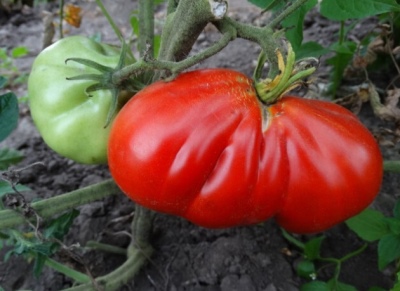
- Authors: V. G. Kachainik, M. N. Gulkin, O. A. Karmanova, S. V. Matyunina (Agrofirma Aelita LLC)
- Year of approval: 2019
- Category: grade
- Growth type: indeterminate
- Appointment: fresh consumption, for juice, for ketchup and tomato paste
- Ripening period: mid-season
- Ripening time, days: 105-110
- Growing conditions: for open ground, for film greenhouses
- Bush size: tall
- Bush height, cm: 170-200
For many gardeners, the new topical plant varieties are a real surprise. One of them is just the Abruzzo tomato. This culture appeared quite recently, but has already managed to establish itself quite well.
Breeding history
Abruzzo, contrary to its name, has nothing to do with Italy. This is a completely ordinary domestic plant, which received approval for cultivation in 2019. It was developed by four breeders at Agrofirma Aelita: Kachainik, Karmanova, Gulkin and Matyunina.
Description of the variety
Abruzzo bushes reach great heights. It can range from 1.7 to 2 m. Green leaves are moderately long. The inflorescence is of the intermediate type. The peduncle is not articulated.
The main qualities of the fruit
Unripe Abruzzo berries are light green in color. They are also characterized by a dark spot. During the ripening process, the fruits will turn red and acquire a typical gloss. The mass of a tomato ranges from 0.22 to 0.3 kg. The fruit looks like a pear and is quite strong, but not excessively ribbed, has a thin rind.
Taste characteristics
Abruzzo tastes like most classic tomatoes. The richness of the gustatory sensations is noted. The sweet taste is more pronounced than the sour notes, but they are also clearly visible. The pulp contains relatively few seeds. The pulp itself is quite fleshy.
Ripening and fruiting
The variety belongs to the mid-season category. After germination, you have to wait an average of 105-110 days. Harvesting usually starts in July and ends in September. Under unstable weather conditions, this rule may be violated.
Yield
Fertility is declared at the level of 11 kg per 1 sq. m. This effect is achieved when using a film culture. Importantly, the entire normative yield will meet the requirements of commercial quality. This information is confirmed by the data of the state varietal register.
The timing of planting seedlings and planting in the ground
Under normal conditions, sowing seeds in seedling containers should be between 1 and 15 March. But gardeners must closely monitor the actual weather and its forecasts, taking into account the characteristics of specific areas. Typical transplant times for vacant land are 15 May to 5 June. With a prolonged cold spring, this period can be increased. Greenhouse or greenhouse cultivation can partly solve the problem.

Growing tomato seedlings is an extremely important process, because it largely depends on whether the gardener will be able to harvest at all. All aspects must be taken into account, from seedbed preparation to planting in the ground.
Landing scheme
It does not differ from the rules for planting many other varieties of tomatoes. Usually you can stick to the standard order of 600x500 mm. Upon further formation, only 2 stems are left. For 1 sq. m leave 3-4 plants. When planting, do not forget to form a tubercle of earth and water the seedlings.

Growing and care
Even when growing Abruzzo seedlings, drafts and excessively bright light should be avoided. Temperature drops for young seedlings are also unacceptable. It is necessary to transplant seedlings into larger containers after the appearance of 2 true leaves. Having formed the main stems, then all new stepchildren are removed so that the development of the bush goes right.
Even at the stage of planting seedlings, it is necessary to sort the seeds. Those of them that float in the water must be thrown away. Such planting material will not bring any benefit anyway. After planting, the first watering is done on the 7-10th day, not earlier. In a greenhouse, irrigation should be done in the morning, and then thoroughly ventilated.
When the crop is ripe, watering is reduced to a minimum. Better yet, stop him altogether. Otherwise, there is a high risk of late blight infection. Periodic spraying of the leaves is recommended for hot periods. Since Abruzzo forms tall bushes, it needs reliable support. Failure to use them can lead to the destruction of the plant under stress. When removing the stepchildren, all the growth ones must be left. If there is the slightest doubt, it is better to leave alone the additional branches.
In open land, unlike greenhouse cultivation, watering the Abruzzo tomato should be done in the evenings. It is necessary to feed the crop with complex fertilizers for tomatoes. Weed the soil around the bushes regularly so that the weeds do not have time to grow. Immediately after watering, the soil should be loosened. For mulching, you can use both compost and humus.
Pests on this variety hardly parasitize. Occasionally it is struck by aphids. This manifests itself in the twisting of the leaf, drying out and dropping of flowers. To combat aphids, it is recommended to use "Fitoverm" or "Actellik". Soap or ash solutions help a lot from available tools.




A plant needs different micronutrients at each stage of growth. All fertilizers can be divided into two groups: mineral and organic. Folk remedies are often used: iodine, yeast, bird droppings, eggshells.
It is important to observe the rate and period of feeding. This also applies to folk remedies and organic fertilizers.


Growing regions
Abruzzo is zoned for various localities of the Russian Federation:
- Middle and Lower Volga region;
- north and northwest of the European part;
- the center of the European part;
- Siberia;
- Ural;
- Far East;
- Central Black Earth Region;
- North Caucasus.

























































































